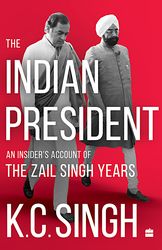Rubber-stamp presidents have been many, copybook presidents a few, corrective presidents fewer, but activist presidents? Only one―Giani Zail Singh. He alone dared to even think of dismissing a prime minister who enjoyed the confidence of the house of people, but not the confidence of his president. And he alone had the ingenuity to keep a bill, that was sent to him for assent, in his pocket and do nothing. The incident gave rise to a new phrase in the lexicon of constitutional practice―‘pocket veto’.
Zail himself has written about it and more in his memoirs, but that account is a totally self-justifying narration of the pangs of an injured mind. On the other hand, former ambassador K.C. Singh, who was on Zail’s presidential staff through his term, gives a more dispassionate yet sympathetic narrative of what was happening in and around the Zail Singh Rashtrapati Bhavan.
Apparently, the distrust between Zail and Prime Minister Rajiv Gandhi had begun much before Rajiv was catapulted to prime ministership following his mother’s assassination. It reportedly began with Zail’s move to restore Andhra Pradesh chief miniter N.T. Rama Rao, who had been dismissed by Governor Ram Lal at the behest of Rajiv’s cohorts led by Arun Nehru. Indira apparently was unaware of the goings-on, and to her credit she stood with the president in the episode.
According to K.C. Singh, Indira held Zail in high esteem. As long as she was alive, the group could not raise its head. The distrust came out in the open during Rajiv’s PM-ship. It worsened after the Coomar Narain spy ring, involving men in both the PMO and Rashtrapati Bhavan, was busted.
The first part of the book is about Zail’s presidency in general, where the author compares between presidents, and tests many of them against the Zail touchstone. He rates Zail high over the NTR episode, over his dignified non-action after Operation Blue Star, and several other instances. The second part is all about the Zail presidency. Both parts are rich in anecdotes, several of them amusing and even funny, involving the men who straddled the corridors of power during Indira’s final years and Rajiv’s five years.
The first part, however, is richer in terms of the insight that it gives into the working of the office of the president under earlier and some of the later presidents. The author has relied on sources other than his own experience in this, yet has taken pains to compare and contrast those with what he experienced during the Zail presidency. He recounts how Lal Bahadur Shastri and Gulzarilal Nanda mismanaged the national language issue, leading to riots in the south, and had to be rebuked by President Dr S. Radhakrishnan; how Jawaharlal Nehru used to consult presidents Rajendra Prasad and Radhakrishnan; and how even the otherwise highly rated A.P.J. Abdul Kalam and Pranab Mukherjee could not stand up to the high standards of corrective presidency when pressed to dismiss the Bihar and Uttarakhand assemblies.
In K.C. Singh’s estimate, while Zail might have been an activist president, Radhakrishnan and K.R. Narayanan come out as near-perfect presidents who turned active when they thought their governments were erring. Shankar Dayal Sharma, too, is regarded in high esteem, and so is V.V. Giri.
The best thing about the book is that every analysis is supported with anecdotes, several of them amusing, culled out from first-hand experience and extensive research. A must-read for anyone interested in the constitutional and political history of India.
The Indian President: An Insider’s Account of the Zail Singh Years
By K.C. Singh
Published by HarperCollins
Pages 275 Price Rs699


